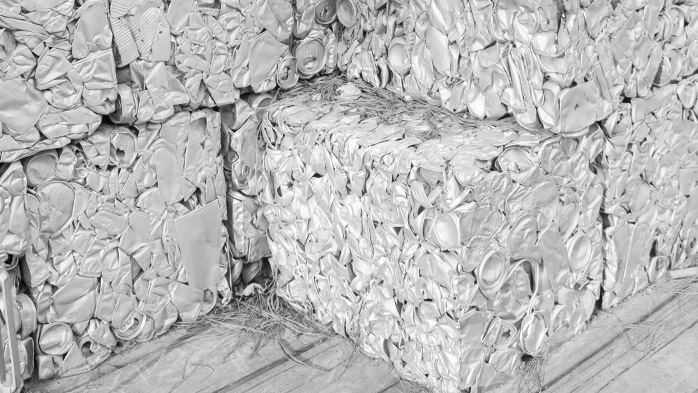Aluminum Scrap Markets

November 20, 2025
Scrap musings: Looking for arbitrage opportunities
Written by Greg Wittbecker
The scrap world has some of the smartest and most enterprising capitalists around. They are constantly doing math, looking for price anomalies as a result of tariff structures.
There have been several recent developments that bear witness to this.
Scrap arbitrage from Canada
Informed sources have been talking about the curious increase in scrap exports from Canada, coming from people who normally ought to be consuming that scrap themselves for secondary metal production.
The logic goes like this:
- You can sell scrap in the US markets at a spread to the Midwest duty-paid P1020 market. Granted that spread is very wide these days, but the absolute price is still very good.
- Concurrently, until the last two weeks or so, the Midwest duty-paid P1020 market was NOT fully covering the 50% tariff. That meant importers, be they Canadian or seaborne origin, were absorbing losses on anything they shipped in.
- This negative import arbitrage meant these producers were better off selling in Canada as duty unpaid or selling to the European duty-paid market (Canada being exempt) or European duty unpaid (if from Middle East or India).
- The Canadian secondary producer took advantage of this by selling their scrap into the US at the elevated absolute prices and turning around and buying duty-unpaid P1020 for purposes of producing their secondary products.
This entire exercise only worked because the 50% Section 232 duty injected 70¢ per pound (¢/lb) into the absolute price of P1020, and scrap has gotten some of that increase. It was also dependent on the duty-paid market not covering the duty. That situation has changed since mid-October.
The Midwest premium has steadily risen since Oct. 1, where it was around 76¢/lb over LME. Once it breached 83¢/lb on Oct. 17, the direct tariff costs were recoverable for the importers of primary aluminum.
This unraveled the scrap-versus-duty-unpaid arbitrage for the Canadian secondary. Now, the Canadians or the seaborne importer have no incentive to sell duty-unpaid metal in Canada. They can resume sales into the Midwest knowing they are now whole on the duty.
A tip of the cap to the Canadian secondary for exploiting this pricing arbitrage between delivered Midwest scrap and duty-unpaid P1020 in Canada.
The risk of primary metal and semi-fabricated products entering as scrap
The idea to adulterate primary metal to make it appear as scrap is not new. The classic example of this came during the collapse of the former Soviet Union in 1991.
When the Soviet military-industrial complex fell, it left aluminum smelters with millions of tons of unwanted aluminum. They started to export it in large volumes, triggering a threatened ban on Russian primary metal entering the EU.
The Russians started casting their primary aluminum into continuous cast rod, which they then cut and declared it as obsolete scrap rod. This product was known by its alloy designation “A5 rod,” and tens of thousands of tons flowed to the West, duty-free as scrap.
Today, barriers to entry for primary metal exist in the US and the EU.
The Section 232 50% tariff places a massive burden on importers seeking to penetrate the US market. This blowout in Midwest P1020 premiums has led to extremely wide discounts for scrap vis-à-vis primary, but the absolute prices are high.
This is why the US is attracting scrap from Europe, which is highly unusual.
The EU’s pending implementation of the Carbon Border Adjustment Mechanism (CBAM) on Jan. 1 raises the burden for prospective primary importers to the region. This is on top of the long-standing 3% duty.
The existing duty-unpaid P1020 premium is $230-$270 per metric ton (/t) over LME cash. The value of the duty-paid P1020 premium is $325-$345/t today, with expectations that CBAM duties will boost the “CBAM duty-paid” market by $40/t, equating to $365-$385/t over LME.
Hydro Aluminum has sounded the alarm on the risk of adulterated primary metal entering Europe to grab some portion of that “carbon-paid premium.”
Remelt Scrap Ingot may not pass scrutiny
Logic says someone remelting scrap into ingot form for ease in storage and shipment should be able to declare that as “scrap.”
Authorities in both the US and EU were smart enough to recognize this as an easy avenue for people to adulterate primary metal with scrap and have sought to declare remelt scrap ingot (RSI) as a derivative of Harmonized Trade Schedule (HTS) 7601, which is primary aluminum.
That means people will have to be more creative in their approaches to get metal past US and EU customs.
The Russian A5 rod is a good example. Another is the precedent set by the Chinese between 2011 and 2014 when we saw substantial “fake semis” flow from China. These products took the form of extrusions, hot band (heavy-gauge continuous cast coils), and cast wheels.
It comes down to how much adulteration has to be done to convince customs officials they are dealing with “scrap” as opposed to primary metal or semi-fabricated products that are covered under both Section 232 and the new CBAM rules.
The Russian A5 rod coils which were slit passed scrutiny 35 years ago, because they appeared to have been rendered commercially damaged. We might expect to see other examples like this in the form of:
- 1100 alloy billet cut into short lengths and described as billet butt ends.
- 1100 hot band that may be slit to render it unusable for cold mill finishing.
- 356 auto castings in wheels, transmission parts, etc.
Why wheel arbitrage falls short
Recent reports indicate there has been an unusual flow of aluminum wheels imports into the US. On paper, these imports seem well in excess of the apparent demand for finished wheels.
The initial hypothesis was these wheels were imported as auto parts, carrying a 25% tariff, and then might be sold off as remelt into primary markets priced on the basis of the Section 232 50% tariff. The idea made sense on paper, but the intrinsic value of scrap 356 wheels isn’t high enough to make the numbers work.
Scrap wheels in the US are worth $1.20-$1.25 per pound ($/lb). Primary aluminum is around $2.17/lb. That spread is a gigantic 92¢-97¢/lb.
The import of these wheels as auto parts saved 25 basis points of duty versus importing as primary aluminum. That equated to around 35¢/lb.
It’s not nearly enough to compensate for the very low value of scrap wheels today (part of that reason is the low value of 5-5-3 silicon).
Even if these wheels were crushed or rendered fully obsolete and could be declared scrap, the math still does not add up.
The avoidance of full Section 232 duty would save the importer 70¢/lb. At most, the savings would merely cover the importer’s sunk casting costs offshore. Even so, we remain doubtful that wheels meaningfully solve the arbitrage.
Potential arbitrage in other “scrap” grades
Notwithstanding the wheel example, other forms of high grade “scrap” might work.
The value of electrical conductor (EC) chops or some 5xxx alloys are good examples. These grades are trading at relatively decent discounts to the Midwest transaction price, around 28¢-36¢/lb.
These discounts might allow crudely produced fake semis in these alloys to work.
Why this matters
The tariff structures in the US invite circumvention because we stand out as a price anomaly in the world. People will be looking to game the system.
The success or failure of any scheme will depend on the relative value of the “scrap” product versus primary metal.
In simple terms, they have to be able to sell the “scrap” at a discount less than the 50% tariff they are avoiding. In today’s market, that’s around 70¢/lb.
The wheel example didn’t work. However, certain high-grade scraps are trading above that threshold.
Customs and Border Protection (CBP) will have to be skilled to determine what is real and what is not a true “scrap” product.
We are not sure with the sheer volume of trade goods subject to tariff that CBP will have the resources or expertise to make accurate calls on these imports. EU Customs officials may face a similar task with the impending CBAM launch.
At the time of this writing, the rules are still being written as to what emissions benchmarks will be used to tax imports. The outcome of that process will determine how big a threat fake semis entering the EU might be.







